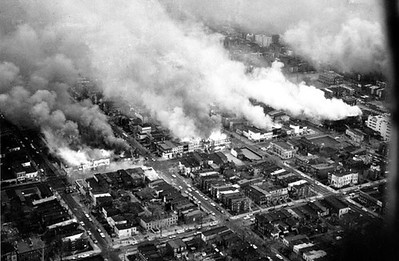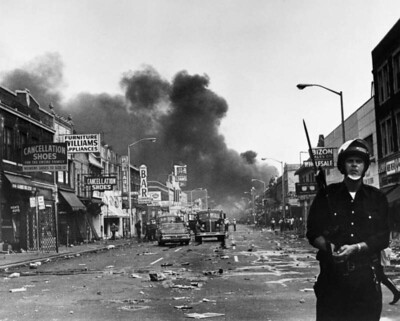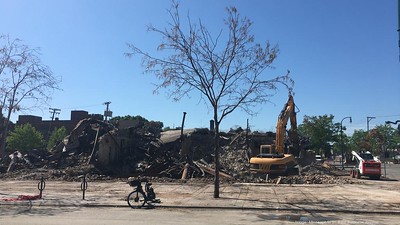"Buildings Matter Too" controversy at the Philadelphia Inquirer
Over the weekend, the editor in chief of the Philadelphia Inquirer, resigned ("Top Editor of Philadelphia Inquirer Resigns After 'Buildings Matter' Headline," New York Times) after controversy in response to a column "Buildings Matter Too," by Inga Saffron, the paper's architecture and urban design writer.
FWIW, Saffron is one of the nation's best newspaper writers on this beat and I have always been envious of Philadelphia having her (she had an opportunity to come to the Washington Post, which she turned down, figuring she could have more impact staying in Philly).
The column makes the point that property destruction associated with the George Floyd protests (and by extension "riots" generally) aren't a good thing for communities.
I don't see how that diminishes protest and outrage over the police killing of George Floyd.
Although people see the wording of the headline as a slight against "Black Lives Matter."
The paper changed the headline of the digital version of the article to "Damaging buildings disproportionately hurts the people protesters are trying to uplift."
I can understand, but don't condone rioting.
I definitely don't condone looting, although a goodly amount of the looting associated with Floyd-related protests two weekends ago was often organized criminality ("NYC looters and vandals chauffeured in cars, had power tools," ABC News), nothing more.
I can't help but think about how too often, especially fueled and accentuated by social media, today's issues and online and real-time organizing lack any room for nuance.
E.g., "Abolish ICE," "Defund Police," etc., leave no room for discussion.
Yes, it's disgusting, tragic and unacceptable what happened to George Floyd.
But we have to recognize simultaneously that property destruction, especially at a mass scale, called by some as "rebellion/resistance" and others "riots" is almost impossible for a center city to recover from.
I am personally familiar with two instances, in the core of Detroit, and on H Street NE, 14th Street NW, and U Street NW in Washington, DC.

H Street neighborhood during the riots, 1968. AP photo.
It took more than 35, almost 40 years, for there to be significant revitalization in those two streets in Washington.
And that was because over time, the general wealth in Washington allowed for the economic revitalization of these areas--stoked by planning, a fair amount of government, and the introduction of a subway system, which made neighborhoods at the core more valuable.

11th and H Street NE, April 1968 riots. Photo: Alexander Lminian.
When I got involved more heavily first as an engaged resident, on H Street revitalization c. 2000, it was grim, and didn't seem like it was anywhere near an upward trajectory.
By contrast, the neighborhoods scarred by rioting in Detroit in 1967 still languish today. And that's the case for most center city neighborhoods that have been devastated in similar events--Newark, Watts/Los Angeles, St. Louis, etc.

Detroit, 1967. AFP photo.
Which was the first thing I thought about when reading about the destruction along Lake Street in Minneapolis ("Neighborhoods that saw riots became food deserts overnight," NPR/Marketplace).

Roughly 20 privately owned buildings on Lake Street between Nicollet Avenue and 32nd Avenue with a combined market value of $19.2 million burned to the ground during the late May riots. That figure barely scratches the surface of the damage done to Lake Street, as countless more business were vandalized and looted. Photo: Nick Halter, Minneapolis/St. Paul Business Journal.

Lake Street, Minneapolis. Photo: Anthony Souffle, Minneapolis Star Tribune.
It's great that building and business owners can sympathize with the destruction ("Minneapolis Family Hopes For Justice Despite Losing Business To George Floyd Protests," NPR), but I don't think they understand that the likelihood is that the commercial district won't revive in the near term and if it does it will take decades ("Lake Street may get rebuilt, but the south side corridor will never be ‘what it was’," Minneapolis/St. Paul Business Journal).
And with all the various pressures faced by independent retailers specifically but also chain retail, the likelihood that their businesses will not come back is higher, although even now there are surviving businesses ("Forever Changed by the Uprising, East Lake Street Remains a Powerful Representation of Minneapolis," Eater).
The thing about the DC riots in 1968 is that for the most part, in two days, they completely destroyed the independent retail sector in Washington, DC and by extension the metropolitan area.
At that time, DC was still the primary retail destination in the city, although suburban shopping mall construction was underway and retail strength was shifting to the suburbs.
The riots destroyed capital formation, the livelihoods of individuals, and community and organizational capital as most of the businesses never reopened, in part because they had no insurance or not enough insurance, and in the aftermath of the riots, the buildings and businesses were seen as worthless anyway.
Today, the Washington DC commercial districts on H Street NE and 14th Street and U Street NW have revived for the most part.

Lake Street, Minneapolis. Photo: Bebeto Matthews, AP.
But independently owned retail has not, although that's less the case for independently owned restaurants -- albeit many of the restaurants are owned by multi-unit more corporate operators mostly operating regionally, but some on an even larger scale.
That means that the middle class is smaller, the ability to generate income and wealth has been reduced, and the retail sector is more concentrated and less local.
And in the case of looting, going forward it's going to make retail businesses a lot more leery of locating stores in center cities. For example, last week, chains like CVS and Target closed stores in many urban locations across the country, as a preemptive move ("Target, Walmart, CVS Close Stores Amid George Floyd Protests").
That's especially true of smaller firms ("Shop Rite owner begs for National Guard after two Philly supermarkets are devastated by looting," Philadelphia Inquirer).

A looted ShopRite, Parkside neighborhood, Philadelphia. Owned by Burn's Supermarkets, a pioneer in opening urban grocery stores in Philadelphia. Photo: Monica Herndon, Philadelphia Inquirer.
Buildings and businesses do matter.
And making that point does not diminish our concern about police killings.
Labels: commercial district revitalization planning, disaster planning, emergency management planning, policing, protest and advocacy, urban revitalization




7 Comments:
wow. Nothing like a circular firing squad.
The article was fine - great even.
The headline was terrible and showed poor judgment.
There's a reason why the editor was fired and not the author.
Welcome to the glorious revolution. It's already practically like Mao's China. If you violate the ideals, messanging or orthodoxies you will be humiliated on social media and exhiled. Past mistakes never leave you and if you are over 35 you can be sure millenials are data-mining your past to create a career opening should the right opportunity arise.
Poor judgement, a little strong. But yes, the headline writer was being cute, the way that sports story headlines often are, and editors should have realized the reaction would have been strong. cf. All Lives Matter, Blue Lives Matter.
And yes, Inga Saffron is always great.
2. I didn't discuss industrial buildings. Apparently one company, 7-Sigma, lost their factory building in the Minneapolis riots, and they believe that the fire department just stood there, not acting, so they are going to move to the suburbs.
https://www.bizjournals.com/twincities/news/2020/06/09/7-sigma-manufacturer-burned-in-riots.html
That's 50 jobs. And we don't know how many are held by city residents.
Still, it makes these kinds of efforts more vulnerable:
https://www.wsj.com/articles/the-company-of-second-chances-11579928401
Probably urban riots were a factor, albeit maybe small, in the moving out of the city of light industrial functions.
Industry was leaving anyway. Consolidating, downsizing, moving to the South or to other countries. But 1960s unrest probably accelerated that trend.
I keep coming back to the phrase "f white decorum". Sure nobody wants rioting, but it's understandable. To spend a lot of ink talking about buildings is not helpful and misses the entire point of this moment in history. Just because cities emptied out in the 70s does not mean rioting caused it. Racism caused it. Caused the riots, caused the fire and police to stoke them, caused people to move to the suburbs. Buildings can be fixed, black and brown lives lost to police violence cannot. The Inquirer was right to fire the editor. Reallyani shocking that anyone at the paper thought it was a good idea, but when you don't hire for antiracism, I guess that's what you get. Here in The Bronx, the community has railed around businesses and helped with clean-up.
This why Urbanism is america fails.
We treat cities as symbols, not as places for people to live.
I understand the point that it's racism's fault. But mostly the neighborhoods don't ever come back.
And that is a huge cost.
It's a fluke that DC's riot scarred neighborhoods were able to revive.
Most other center cities lack DC's structural advantages (federal government presence, employment, density at the core, attractive residential building stock, subway system).
Still, it wiped out independent business. A lot of capital. Etc.
-----
I talked a few times to the person who claims to be the person who threw the first rocks at 14th and U Streets. He uses the term "rebellion."
Perspectives vary...
Post a Comment
<< Home